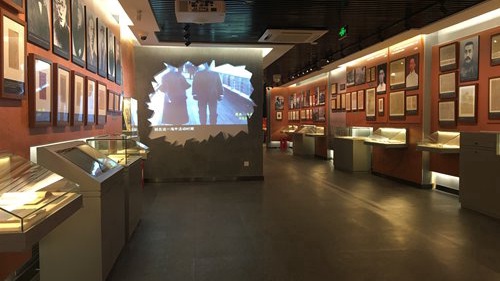To memorialize Marxism and history, an exhibition about early Marxism in China opened semi-permanently at the Beijing Luxun Museum and the New Culture Movement Memorial of Beijing.
On the outside wall is a red panel with portraits of Karl Marx and Friedrich Engels. More socialism awaits inside the hall. Stepping inside, the first, and second, impression is red: red walls, red flags and red book covers.

Originating with the French Revolution, Jacobins flew the red flag as the symbol of opposition to authorities. Since then, red has remained linked to radical parties and revolution.
Three portraits
Inside the main hall, perhaps the most eye-catching display is three portraits: Vladimir IIich Lenin (1870-1924), Engels (1820-1895) and Marx (1818-1883).
All black and white, their portraits were painted by Jiang Zhaohe (1904-1986), a noted modern Chinese painter and art educationalist.
Upon closer inspection of the pictures, it is not hard to spot what the three pioneers of socialism all have in common: beards and suits.
Aside from that, however, there are much deeper connections that are explained more clearly in the exhibition.
A successful revolutionary, Lenin became a pillar of the Soviet Communist Party as well as the Union of Soviet Socialist Republics.
Taken by supporters as a champion of socialism and the working class, Lenin is the ideological figurehead behind Marxism-Leninism and he left a prominent influence over the international communist movement.
Engels, a German philosopher, social scientist, journalist and businessman formed Marxist theory together with Marx.
As a co-worker and Marx's best friend, he co-authored The Communist Manifesto and other Marxist works.
Notes in London
Marx, regarded as the one of the most influential figures in human history, built a foundation for later study of the relationship between economics and politics and is always cited as one of the principal architects of modern social science.
Walking inside the second hall of the exhibition, two glass showcases stand in the most prominent place.
Looking closely, there are pages in a glass box with Marx's handwriting, recording his thoughts and unique insights into economic problems during his time in London. All his works in London were collected and named "notes in London" by later generations.
In London Marx focused his study on capitalism and spent time at the reading room in the British Museum.
In the Chinese version of this story, Marx left a pair of footprints on the floor from all his reading at the same seat.
By 1857, Marx had finished 800 pages of short essays and notes on capital, landed property, wage labor, the state, foreign trade and the world market.
Unfortunately, none of them appeared in a printed version until 1939 as the Outlines of the Critique of Political Economy.
Big screens
Knowledge and amusement are two key factors needed to attract visitors. To attract the young, two interactive big screens feature documentaries about the history of socialism.
Paintings and pictures provide a window for the young to imagine the scenes of a great revolution.
At the exit is a quiz machine to test what knowledge one has gained from the exhibition.
Playing the game is a primary school girl who concentrates on choosing the right answer to get a high grade.



